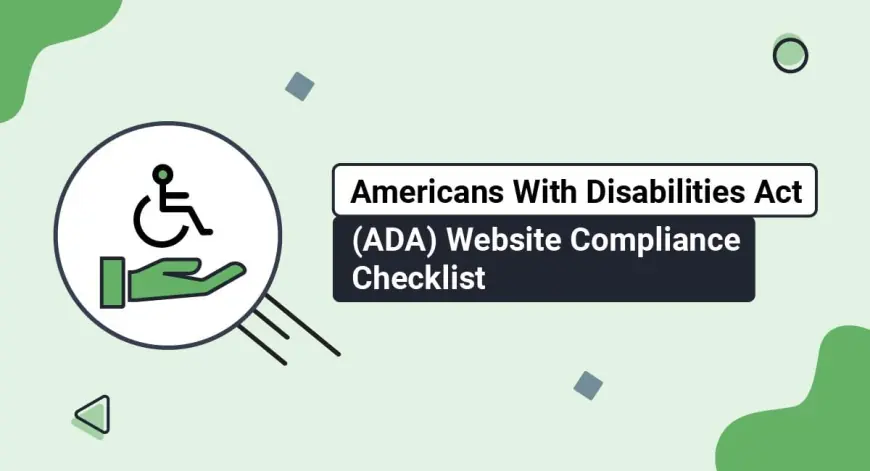Ensuring Digital Accessibility: Why ADA Website Compliant Design Matters in 2025
ADA Website compliant

Understanding the Importance of Digital Accessibility
In today's digitally driven economy, having an online presence isn't enough; ensuring that presence is accessible to all users, including those with disabilities, is now essential. ADA Website compliant design is more than just a legal requirement—it's a commitment to inclusivity, equal opportunity, and user experience. The Americans with Disabilities Act (ADA) mandates that businesses provide accessible web content, ensuring that users with visual, auditory, motor, or cognitive disabilities can navigate, interact with, and benefit from the information and services offered. With the number of lawsuits against non-compliant websites steadily rising, organizations are under growing pressure to ensure their digital content meets accessibility standards.
What Does It Mean to Be ADA Website Compliant?
To be ADA Website compliant means aligning your website’s structure, design, and content with the Web Content Accessibility Guidelines (WCAG), the global standard for web accessibility. This includes features such as text alternatives for non-text content, keyboard navigation, content readability, and compatibility with assistive technologies. Businesses that fail to comply can face serious legal consequences, including lawsuits, fines, and reputational damage. However, compliance also opens the door to a broader audience and demonstrates a brand’s commitment to equality. Being proactive about compliance can improve site usability for all visitors, not just those with disabilities.
The Legal and Financial Risks of Non-Compliance
The legal implications of not being ADA Website compliant are significant. The past few years have seen a dramatic increase in lawsuits targeting websites that fail to meet accessibility standards. These legal actions are not limited to large corporations; small and mid-sized businesses are equally vulnerable. Beyond legal penalties, there are reputational risks. A business that is not inclusive may be seen as out of touch or discriminatory, alienating a segment of its customer base. Investing in compliance not only reduces risk but can also increase market reach and consumer trust.
Practical Steps to Achieve Compliance
Achieving ADA Website compliant status involves a comprehensive audit of your existing website followed by implementation of necessary changes. This includes adding alt text to images, ensuring sufficient color contrast, making all functions accessible via keyboard, and ensuring content is readable and understandable. It's also important to perform regular accessibility testing using tools and real-user feedback. Businesses should work with accessibility specialists or web development experts who understand the nuances of ADA compliance. Embedding accessibility into the design and development lifecycle ensures that your digital platform remains compliant as your content evolves.
Integrating Accessibility with User Experience
Being ADA Website compliant does not mean sacrificing aesthetics or functionality. In fact, accessibility often enhances user experience for all visitors. For example, clear navigation, readable fonts, and consistent layouts benefit everyone. Accessibility features like captions, transcripts, and voice recognition also support users in noisy environments or on the go. Prioritizing accessibility means designing for the edge cases, which often results in a more intuitive and efficient experience for the general population. By integrating accessibility from the beginning, businesses can avoid costly redesigns later and ensure that inclusivity is part of their brand identity.
The Competitive Advantage of ADA Compliance
Companies that commit to being ADA Website compliant gain more than just legal peace of mind. They position themselves as leaders in social responsibility, improving brand loyalty and consumer trust. Accessibility can also drive more traffic to your website through improved SEO, as many accessibility practices align with search engine algorithms. Additionally, compliant websites can engage with the growing segment of users who rely on assistive technologies. By reaching this underserved market, businesses can unlock new revenue streams and demonstrate their commitment to equality and inclusion in the digital space.
Common Misconceptions About ADA Compliance
One of the biggest misconceptions is that ADA Website compliant design is optional or only relevant for certain industries. In reality, any business with a digital presence should prioritize compliance. Another false belief is that accessibility is a one-time task. True compliance is an ongoing effort that requires monitoring and updates as technologies, user needs, and regulations evolve. Some also assume that accessibility is only about the visually impaired, but ADA compliance covers a wide range of disabilities. Educating teams and stakeholders about the real scope of accessibility is critical to long-term success.
FAQs
What does ADA Website compliant mean?
It refers to a website that meets the accessibility requirements outlined by the Americans with Disabilities Act, ensuring equal access to online content for users with disabilities.
Is ADA compliance mandatory for all websites?
While the ADA doesn't specify website requirements directly, courts have increasingly interpreted it to apply to digital platforms, especially those related to businesses and public services.
How can I test if my website is ADA compliant?
There are automated tools and manual audits available. It's recommended to work with accessibility experts who can evaluate your website against WCAG standards.
What are the penalties for non-compliance?
Fines, lawsuits, and required settlements are common consequences. Non-compliance can also result in reputational damage and loss of customer trust.
Can ADA compliance improve my SEO?
Yes. Many accessibility features, such as alt text and clear structure, also improve search engine rankings and overall usability.
Conclusion
Ensuring your website is ADA Website compliant in 2025 is no longer optional—it's essential. As digital platforms become the primary mode of engagement for consumers, your commitment to accessibility can shape brand perception, legal standing, and customer loyalty. Beyond just meeting legal standards, embracing ADA compliance promotes a more inclusive internet, serving all users equally. It reflects a company’s values and foresight. If you're unsure where to start, it’s time to Check Out Now how expert accessibility services can help you move forward with confidence.
What's Your Reaction?
 Like
0
Like
0
 Dislike
0
Dislike
0
 Love
0
Love
0
 Funny
0
Funny
0
 Angry
0
Angry
0
 Sad
0
Sad
0
 Wow
0
Wow
0

















































